 Neuronal signaling does more than transmit mental information. It also, regulates the microenvironments of cells and their behavior in bodily organs. These signals attempt to maintain stability. Communication between neurons and many other cells stimulates and regulates inflammation and the functions of stem cells. Communication from T cells and immune cells with brain cells are critical to determine levels of cognitive function. Complex multi cell synapses—including multiple neurons, multiple immune cells, glia and blood cells and blood lining cells—determine many important aspects of inflammation including pain. Also, neurons interact with immune cells on a local basis sideways from un-myelinated axons.
Neuronal signaling does more than transmit mental information. It also, regulates the microenvironments of cells and their behavior in bodily organs. These signals attempt to maintain stability. Communication between neurons and many other cells stimulates and regulates inflammation and the functions of stem cells. Communication from T cells and immune cells with brain cells are critical to determine levels of cognitive function. Complex multi cell synapses—including multiple neurons, multiple immune cells, glia and blood cells and blood lining cells—determine many important aspects of inflammation including pain. Also, neurons interact with immune cells on a local basis sideways from un-myelinated axons.
 As neurons innervate all organs in the body, they, also, stimulate stem cells in the bone marrow. In this role they regulate the number of blood and immune cells that are produced. While performing these functions, various neurons, also, stimulate cancer cells in different ways. Neuron signals can help cancer by increasing aggressiveness, mobility and metastasis. Neuron signals can, also, help fight cancers and inflammation. Complex relationships between all these different cells and many types of neurotransmitters, cytokines, and other factors can have both positive and negative effects on stimulating and stopping cancer. Neuronal signals in inflammation and cancer can have positive and negative outcomes. It is the constant chatter between all of these cells that determines the outcomes.
As neurons innervate all organs in the body, they, also, stimulate stem cells in the bone marrow. In this role they regulate the number of blood and immune cells that are produced. While performing these functions, various neurons, also, stimulate cancer cells in different ways. Neuron signals can help cancer by increasing aggressiveness, mobility and metastasis. Neuron signals can, also, help fight cancers and inflammation. Complex relationships between all these different cells and many types of neurotransmitters, cytokines, and other factors can have both positive and negative effects on stimulating and stopping cancer. Neuronal signals in inflammation and cancer can have positive and negative outcomes. It is the constant chatter between all of these cells that determines the outcomes.
This post will review new material on how neuronal signaling affects all aspects of inflammation and how it can, also, affect the development of cancer.
Autonomic Nervous System
 The autonomic nervous system directs most of the activity of muscles and organs including the fight and flight response, so it is not surprising that neuronal activity stimulates all of the traditional aspects of inflammation as well—pain, redness, swelling and fever. Neurons are found to use less powerful versions of inflammation pathways for neuroplasticity. Neurons, also, stimulate division of stem cells to make more blood and immune cells and this activity can be co-opted by cancer cells. The nervous system regulates stem cell activity and therefore helps or hurts cancer stem cells. Cancer cells use this neuron activity to advance their own community.
The autonomic nervous system directs most of the activity of muscles and organs including the fight and flight response, so it is not surprising that neuronal activity stimulates all of the traditional aspects of inflammation as well—pain, redness, swelling and fever. Neurons are found to use less powerful versions of inflammation pathways for neuroplasticity. Neurons, also, stimulate division of stem cells to make more blood and immune cells and this activity can be co-opted by cancer cells. The nervous system regulates stem cell activity and therefore helps or hurts cancer stem cells. Cancer cells use this neuron activity to advance their own community.
Stem cells operate in special microenvironments, called niches. Neurons regulate these microenvironments of cells through autonomic fibers that are found working in every bodily organ
 The sympathetic system activates blood flow and organs related to stress and alertness. The parasympathetic system activity corresponds to metabolic activity at rest. They both, also, regulate particular cellular activity such as cell death and new cell growth under emergency situations in an organ. Sympathetic neurons regulate brown fat energy balance and hormone secretions. Parasympathetic neurons regulate growth of epithelial cells (see the very intelligent Intestinal epithelial cell and the intelligent skin cell) and regulation of smooth muscles on blood vessels and the heart.
The sympathetic system activates blood flow and organs related to stress and alertness. The parasympathetic system activity corresponds to metabolic activity at rest. They both, also, regulate particular cellular activity such as cell death and new cell growth under emergency situations in an organ. Sympathetic neurons regulate brown fat energy balance and hormone secretions. Parasympathetic neurons regulate growth of epithelial cells (see the very intelligent Intestinal epithelial cell and the intelligent skin cell) and regulation of smooth muscles on blood vessels and the heart.
The sympathetic system is very active in the bone marrow, which makes blood cells and many immune cells. Nervous stimulation regulates the production of blood cells and of bone (leptin signal at ?2 adrenergic receptors on bone cells). Stem cells move from bone into blood and organs after stimulation from these signals, as well. Neurons modulate immune cells from the bone marrow both to increase and to decrease inflammation.
Neuronal Control of Blood Cells in the Niche

Blood cell levels are maintained by stem cells coming from the bone marrow, which are able to produce all types. The production of new cells is based on local environmental needs. The activity of the stem cell is determined by signals from local stromal cells and neuronal signals. Stem cells are inactive in the niche until needed and are activated by stress, particularly damage and loss of blood where new cells are needed. The sympathetic system is a major part of the function of the niche.
There is a lot of signaling between the many types of stromal cells of the bone marrow. There are two types of blood vessels in the bone. One type is sinusoids and the second are arterioles that are highly connected to sympathetic nerves. The sympathetic fibers are connected with cells surrounding the blood vessels. The effects of this neuro-reticular complex are inhibitory.
Other nervous tissues regulate the niche. A special kind of Schwann cell that doesn’t make myelin is inhibitory. There are many different signals involved in these complex processes—substance P, neurokinin-A and many cytokines. Stem cells are mobilized by chemokines as well as neuronal stimulation. Activation of stem cells is stimulated by ?2 and ?3 adrenergic receptors. Sympathetic neurons and stromal cells have electrical synapses in the sinusoids. Niche cells, also, communicate with each other and send more of the sympathetic signals between them. This stimulation causes stem cells to have a circadian activity with more activity at night. Dopamine signals are also used for stem cells mobility.
Transplantation depends upon niche cells making more cells in the blood. Peripheral neuropathy hurts the stem cell niche and transplantation efforts. It does this by stimulating unnecessary cell divisions through the signal nestin. If you want to find out more about this for research purposes, checking out sites like https://buypbmcs.com/ should help you understand this further.
Neuronal Control of Inflammation
 It is now known that neuronal activity mediates all four classical symptoms of inflammation—fever, redness, heat and pain. These same signals can be involved in helping and hurting cancer development. The great complexity of inflammation mechanisms in different circumstances interacts with the many ways cancer develops. With autonomic fibers innervating all of the organs that produce cancer, there are many possible interactions that are just now being discovered.
It is now known that neuronal activity mediates all four classical symptoms of inflammation—fever, redness, heat and pain. These same signals can be involved in helping and hurting cancer development. The great complexity of inflammation mechanisms in different circumstances interacts with the many ways cancer develops. With autonomic fibers innervating all of the organs that produce cancer, there are many possible interactions that are just now being discovered.
Inflammation is very complex involving elaborate signaling between many different immune cells and brain cells. Neurons themselves can cause all the different inflammation activities and, in fact, uses these pathways in types of neuroplasticity. The synapses involved in this activity are not the simple pre and post synaptic neurons surrounded by an astrocyte, but rather much more complex large synapses involving the pre synaptic neuron communicating with other post synaptic neurons, as well as astrocytes, microglia, T cells, endothelial lining cells that form blood vessels and special cells that line the choroid plexus of the cerebral spinal fluid. These complex synapses are critical for neuroplasticity of cognition, learning, pain and epilepsy. Full inflammation increases blood flow, attracts many immune cells, releasing many signals including cytokines, chemokines, prostaglandins, serotonin, histamine, and many other immune factors. These signals can, also, affect cancer.
Neurons trigger small versions of inflammation called “para-inflammation,” such as coordinated actions of immune and blood vessel cells. These can be positive or negative to the organ based on how strong they are and where they are. Signals are glutamate, substance P, calcitonin gene related peptide (CGRP), brain derived neurotrophic factors (BDNF), fractaline, and ATP.
Inflammation is, also, actively terminated by neurons, so that it won’t cause further disease. Choroid cells control the gate where immune cells enter the brain. With neuronal signals, they regulate immune and brain signals to start and stop inflammation. To stop inflammation, the choroid cells, attract particular T cells to orchestrate this decrease.
Complexity in Neurons Stimulating Inflammation
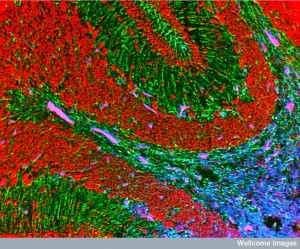 Inflammatory signals of innate response stimulate sensory neurotransmitters and neuropeptides, which have complex conflicting results. Inflammation is further stimulated by corticotropin releasing hormone, substance P, calcitonin gene related peptide. These cause pain, increased blood flow and leakiness of blood vessels. The opposite anti-inflammatory signals occur with glucocorticoids from the hypothalamus-pituitary-adrenal signals.
Inflammatory signals of innate response stimulate sensory neurotransmitters and neuropeptides, which have complex conflicting results. Inflammation is further stimulated by corticotropin releasing hormone, substance P, calcitonin gene related peptide. These cause pain, increased blood flow and leakiness of blood vessels. The opposite anti-inflammatory signals occur with glucocorticoids from the hypothalamus-pituitary-adrenal signals.
Sympathetic neurons trigger movement of immune cells into a region, while at the same time inhibiting monocytes and dendritic cells by cytokines. Neurons play a complex role in both early stimulation and later inhibition of inflammation. Norepinephrine stimulates inflammation at low concentrations with ? adrenergic signals and the opposite with high concentrations at ? adrenergic receptors. Each type of immune cell has different responses from this. T and B cells only have ?, but helper T cells have none. Mononuclear cells have different receptors in different microenvironments. Chronic and acute stimulation have different effects.
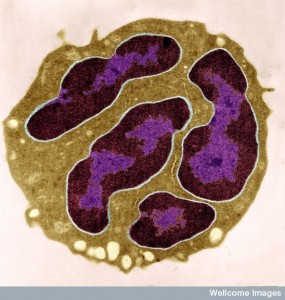 Leukocytes are critical for any response and need adrenergic signals to regulate their movements. The neurons affect the blood cell’s stickiness related to their travel in the blood vessel tied to the circadian rhythms. The parasympathetic cholinergic neurons do the opposite and lower stickiness stopping the traffic. A recent signal was, also, found in the sciatic nerve. This is a complex signal from the vagus inhibiting pro inflammatory cytokines but not those from macrophages. Surprisingly, this anti inflammatory vagus affect needs ?2 adrenergic receptors on lymphocytes. Sympathetic fibers, also, stimulate lymph tissue preparing more cells.
Leukocytes are critical for any response and need adrenergic signals to regulate their movements. The neurons affect the blood cell’s stickiness related to their travel in the blood vessel tied to the circadian rhythms. The parasympathetic cholinergic neurons do the opposite and lower stickiness stopping the traffic. A recent signal was, also, found in the sciatic nerve. This is a complex signal from the vagus inhibiting pro inflammatory cytokines but not those from macrophages. Surprisingly, this anti inflammatory vagus affect needs ?2 adrenergic receptors on lymphocytes. Sympathetic fibers, also, stimulate lymph tissue preparing more cells.
In all of the discovered pathways, there are variable results in different circumstances.
Neurons Controlling Cancer
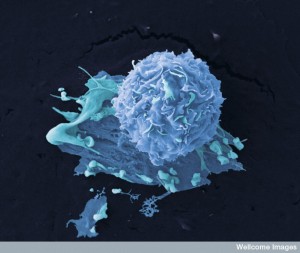 Many of the same processes mentioned with inflammation can affect cancer and again with complex results. Neuronal signaling influences response to stress, depression, trauma, inflammation and depression. Stress, depression and social isolation can all affect immune cell functions. Traumatic life events are associated with twice the incidence of breast cancer. Chronic depression is associated with poor treatment results. A recent study showed this effect with prostate cancer and depression. Stress from obesity and diabetes also decreases treatment outcomes. Neuronal signaling is involved in all affects making new blood cells, stem cell niche affect tumor cells growth.
Many of the same processes mentioned with inflammation can affect cancer and again with complex results. Neuronal signaling influences response to stress, depression, trauma, inflammation and depression. Stress, depression and social isolation can all affect immune cell functions. Traumatic life events are associated with twice the incidence of breast cancer. Chronic depression is associated with poor treatment results. A recent study showed this effect with prostate cancer and depression. Stress from obesity and diabetes also decreases treatment outcomes. Neuronal signaling is involved in all affects making new blood cells, stem cell niche affect tumor cells growth.
Leukemia
The microenvironment in the bone marrow is altered by the myeloid leukemia cells to stimulate more cancer through production of more special leukemic stem cells. Communication between the bone marrow cells and stem cells, along with neuronal signaling, are critical in this process. Sympathetic fiber signaling is disrupted decreasing normal stem cells.
These special leukemic cells secrete growth factors and chemokines that alter the other niche cells that would normally make up the structure of the bone micro region. Instead they become cells that would normally only appear during inflammation. This makes them less effective and allows the leukemia stem cells to take over the niche. This occurs along with damage to the sympathetic neurons in the bone.
The leukemic cells developed ?1 adrenergic receptors, which blocked the creation of normal bone cells leaving holes in the bone. With less sympathetic signals to normal cells there was a decrease of the normal stem cells and increase of the abnormal types. Other signals with IL-1? caused some stem cells to kill themselves.
Solid Tumors
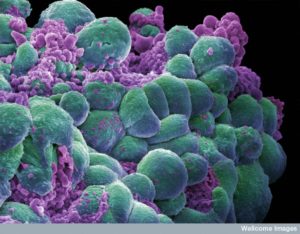 Several cancers invade the space that surrounds neurons. Cancer cells benefit from being next to the neuron, since neurons have growth factors and factors that work against programmed cell death. Neurotransmitters, also, help cancer cells grow and expand.
Several cancers invade the space that surrounds neurons. Cancer cells benefit from being next to the neuron, since neurons have growth factors and factors that work against programmed cell death. Neurotransmitters, also, help cancer cells grow and expand.
Cancer cells (prostate, colon, bladder, esophageal) are even able to secrete special molecules that normally guide axons in their travels, thus attracting more neuronal axons to the growing cancer. This is similar to cancer cell’s ability to attract the growth of more blood vessels.
Cancers develop their own regional nervous system. As the cancer grows, they secrete their own neurotrophic factors—brain derived neurotrophic factor (BDNF), glial derived neurotrophic factor (GDNF) and neural growth factor (NGF)—to grow their own neuronal connections inside the tumor. These neurons growing in the cancer include special nerves such as prostate nerves and both sympathetic and parasympathetic fibers. In pancreatic cancer, there are more sensory fibers as well.
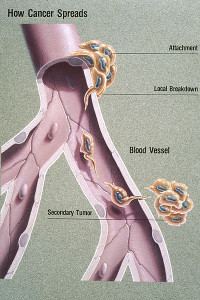 Sympathetic and parasympathetic nerves then help the cancer grow and metastasize. ?2-adrenergic signals in breast and ovarian cancer help them grow and spread. It helps stimulate movement of cancer cells (inhibited by beta blockers). These adrenergic receptors are found on many stromal cells including smooth muscle, blood vessels, macrophages and various other immune cells, all part of the bone marrow milieu. They are all stimulated and inhibited by autonomic signals.
Sympathetic and parasympathetic nerves then help the cancer grow and metastasize. ?2-adrenergic signals in breast and ovarian cancer help them grow and spread. It helps stimulate movement of cancer cells (inhibited by beta blockers). These adrenergic receptors are found on many stromal cells including smooth muscle, blood vessels, macrophages and various other immune cells, all part of the bone marrow milieu. They are all stimulated and inhibited by autonomic signals.
Macrophages are the most likely to take neuronal stimulation in the cancer milieu. When stimulated by norepinephrine they trigger more blood vessels for the cancer and help change the cancer cells to be stronger and more invasive.
Another group of immune cells responds to acetylcholine neurons. These cells include B and T (CD4) lymphocytes. T helper cells have ?2 adrenergic receptors. Some studies showed stress increased more tumor cells, less leukocytes and less T cells.
Blood vessels in the cancer respond to sympathetic neurons with dopamine, which lowers the blood vessels counteracting the norepinephrine effects. Dopamine has been used with chemotherapy for this effect.
Neuropeptides, also, affect tumors. Some increase blood vessels and some decrease them. These affects can alter the entire body’s response increasing cancer travel and metastasis. ?-adrenergic signals can stop metastasis with anti-inflammatory medications. Also, muscarinic parasympathetic signals increased metastasis in lymph nodes.
Neuronal Signals in Inflammation and Cancer
The remarkable intelligence of cells is being demonstrated wherever detailed study is done. A previous post described the many extremely complex ways that cells have back and forth chatter, which determines much of what occurs. For example, the single intestinal epithelial cell sits between trillions of microbes on one side and immune cells on the other. This cell is constantly communicating with the microbes helping the positive ones (digestion, vitamin production, etc) and fighting the negative ones along with constant communication with each type of immune cell below, which help in dealing with the microbes. This same complex signaling is described in skin cells, T cells, astrocytes, microglia, leukocytes and even platelets. Cancer cells communicate among the cells of their community, like bacteria, but, also, with all of these other cells.
The chatter between cells related to inflammation and cancer is extremely complex and just now being discovered. Recently, neuronal communication with stem cells in the bone marrow, which produces blood cells, has been included in these pathways. It is now clear that complex neuronal communication with many cells influences the development of cancer. Cancer joins in and co opts the signaling for its own uses, such as building its own blood vessels and nervous system.
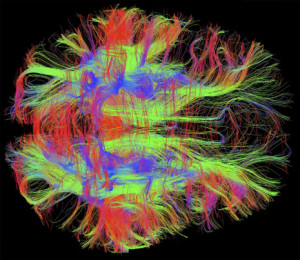 We don’t know what the mind is, or how neurons interact with mind. But, the strong association of neuronal activity and mental events is clear. Neuronal signaling is now being shown to be critical for immune activity and stimulation of stem cells for blood. Recent research shows neurons are critical to both stimulate and fight cancer. The recent work shows autonomic effects on stem cells, inflammation and movement of immune cells. These open up new possible therapies for cancers.
We don’t know what the mind is, or how neurons interact with mind. But, the strong association of neuronal activity and mental events is clear. Neuronal signaling is now being shown to be critical for immune activity and stimulation of stem cells for blood. Recent research shows neurons are critical to both stimulate and fight cancer. The recent work shows autonomic effects on stem cells, inflammation and movement of immune cells. These open up new possible therapies for cancers.
This association of neuronal stimulation influencing inflammation and cancer, also, brings up the old question of psychosomatic influences on immune function and cancer. These pathways create direct neuronal links between the brain and immune function and cancer. How is the mind involved?



